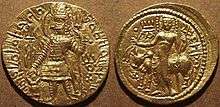Oesho
Oesho (Bactrian: Οηϸο) was a Kushan deity represented on Kushan coins. He was apparently one of the titular deities of the dynasty. He is generally identified with Shiva.[1]

Kushan worshipper with Oesho, Bactria, 3rd century CE.[2]
By the time of the Kushan emperor Ooishki (Bactrian Οοηϸκι; often Romanised as Huvishka), who reigned in 140–180 CE, Oesho and the female deity Ardoksho (Ardoxsho; Ardochsho; Ardokhsho) were the only deities appearing on Kushan coins.
Connections to several contemporaneous deities worshipped by neighbouring cultures have been suggested.
- During the Kushan era, Oesho was often linked to the Hindu concept of Ishvara, which was embodied by the god Shiva;[3] Oesho may share the same etymology as Ishvara and/or represent a variant of the word in the Bactrian language spoken by the Kushans.[4][5]
- Similarities have retrospectively been identified with the Avestan Vayu.[6][7]
- Some later representations, evidently influenced by Greco-Bactrian culture, depict Oesho with a trishula, the traditional implement of Shiva, similar to a trident that is part of Poseidon’s iconography.[8]
 Oesho, with a second human face, and the head of a horned animal
Oesho, with a second human face, and the head of a horned animal Coin of the Kushan king Kanishka II with, on the reverse, a depiction of Oesho and the word "Oesho" in modified Greek script.
Coin of the Kushan king Kanishka II with, on the reverse, a depiction of Oesho and the word "Oesho" in modified Greek script.
Notes
- Rosenfield, John M. (1967). The Dynastic Arts of the Kushans. University of California Press. p. 93.
- Metropolitan Museum of Art exhibition
- Sivaramamurti, p. 56-59.
- The Dynasty Arts of the Kushans. University of California Press. 1967. pp. 92–93.
- Blurton, T. Richard (1993). Hindu Art. Harvard University Press. p. 84. ISBN 0-674-39189-6.
- Sims-Williams, Nicolas. "Bactrian Language". Encyclopaedia Iranica. 3. London: Routledge & Kegan Paul.
- H. Humbach, 1975, p.402-408. K.Tanabe, 1997, p.277, M.Carter, 1995, p.152. J.Cribb, 1997, p.40. References cited in "De l'Indus à l'Oxus".
- Coins of Vima Kadphises
gollark: I redirected all access to `.php` to an osmarks internet radio™ stream.
gollark: Yes.
gollark: So stuff appears to still be mostly *functioning*, but I can't do much because something something load average of 15.
gollark: You're in Hong Kong. This is 3 distance → light speed latency.
gollark: helloboi.tk is still working.
References
- Bopearachchi, Osmund (2003). De l'Indus à l'Oxus, Archéologie de l'Asie Centrale (in French). Lattes: Association imago-musée de Lattes. ISBN 2-9516679-2-2.
This article is issued from Wikipedia. The text is licensed under Creative Commons - Attribution - Sharealike. Additional terms may apply for the media files.